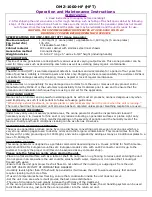
INSTALLATION
e-BALTIC-IOM-2020.12-EN
24
INSTALLATION
PRELIMINARY CHECKS
Before installing the equipment, the following points MUST be checked:
•
Have the forklift protections been removed?
•
Is there sufficient space for the equipment?
•
Is the surface on which the equipment is to be installed sufficiently solid to withstand its weight? A detailed study of the
frame must be made beforehand.
•
Do the supply and return ductwork openings excessively weaken the structure?
•
Are there any obstructing items which could hinder the operation of the equipment?
•
Does the electrical power available correspond to the equipment's electrical specifications?
•
Is drainage provided for the condensate?
•
Is there sufficient access for maintenance?
•
Installation of the equipment could require different lifting methods which may vary with each installation (helicopter or
crane). Have these been evaluated?
•
Ensure that the unit is installed in accordance with the installation instructions and local applicable codes.
•
Check to ensure that the refrigerant lines do not rub against the cabinet or against other refrigerant lines.
In general, make sure no obstacles (walls, trees or roof ledges) are obstructing the duct connections or hindering assembly and
maintenance access
INSTALLATION REQUIREMENTS
The surface on which the equipment is to be installed must be clean and free of any obstacles which could hinder the flow of
air to the condensers:
•
Avoid installing two units side by side or close to each other as this may restrict the airflow to the condensers.
•
Uneven surfaces are prohibited. The surface must be flat and respect a maximal flatness of 0.5mm per linear meter (in both
directions length and width).
•
The entire surface of the chassis must rest on a support (except for the Lennox PIED option provided for this purpose).
•
For the installation of a machine without the roofcurb or box supplied by Lennox, it is imperative that the load of the
machine is evenly distributed under the entire frame.
Before installing a packaged Rooftop unit, it is important to understand:
•
The direction of prevailing winds
•
The direction and position of air flows.
•
The external dimensions of the unit and the dimensions of the supply and return air connections.
•
The arrangement of the doors and the space required to open them to
access the various components
CONNECTIONS
•
Ensure that all the pipework crossing walls or roofs are secured, sealed and insulated.
•
To avoid condensation problems, make sure that all pipes are insulated according to the temperatures of fluids and type of
crossed premises.
NOTE: The protection sheets fitted to the finned surfaces must be removed prior to start up
The customer must provide the appropriate equipment to protect the supply line to the unit. A differential of 300 mA is
recommended.
If the unit is fitted with variable speed fan condensers or variable speed pumps or compressors, a type B differential is
recommended.
Содержание e-Baltic D BOX 55
Страница 51: ...HEAT RECOVERY e BALTIC IOM 2020 12 EN 48 STEP 3 FITTING STEP 4 CHECK 0 15 mm SAME LEVEL...
Страница 91: ......
















































